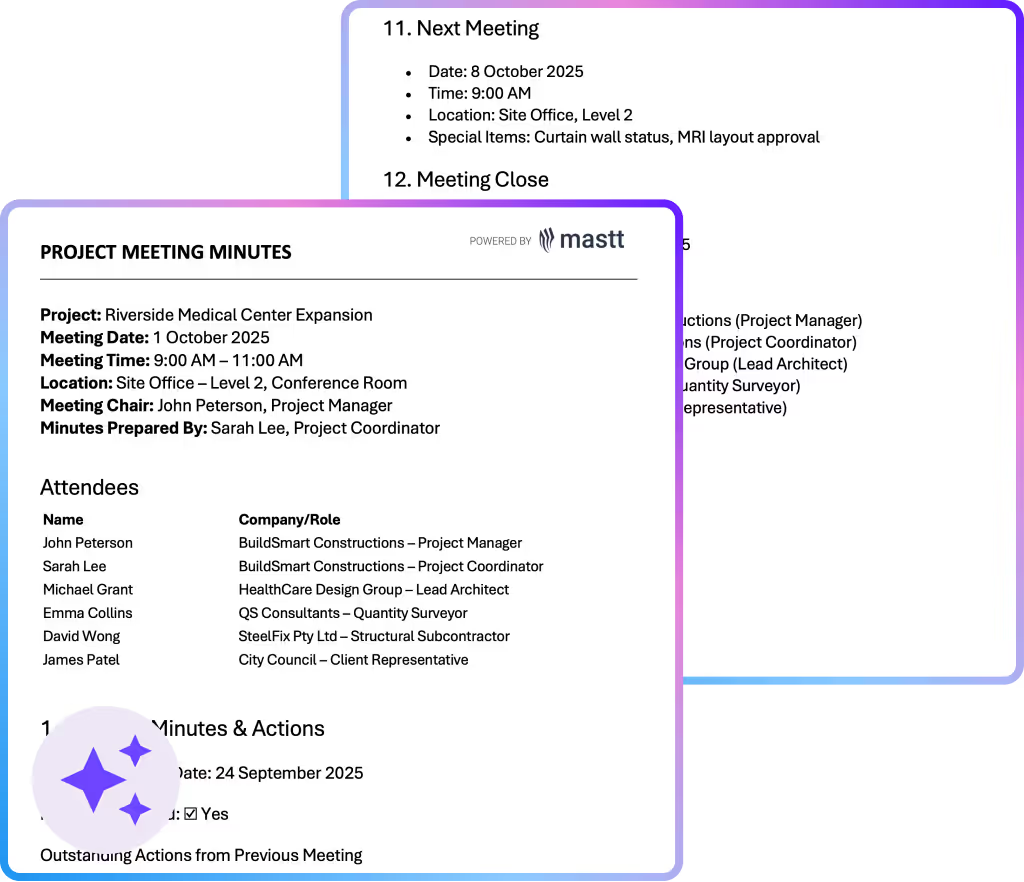
Recognize this Spiderman meme? This could be you and the rest of your team if you don't take down proper meeting minutes. Surely, we've been to meetings where we forgot who's responsible for which, and the dreaded "But I thought you were handling that..." conversations.
Meeting minutes may not be the most exciting task or interesting read you'll have. Still, it is as important if you want to succeed in your capital projects and may even come in handy later for compliance or dispute under legal circumstances. You must document key takeaways of what was discussed in the meeting – agreements, assignments, responsibilities, deliverables, and whatnot.
But how do you take down meeting minutes effectively and ensure that all details are clear for everyone? This article will help you break down meeting minutes and how to write one that would benefit everyone on the team and your overall goal.
Understanding the Role of Meeting Minutes
Meeting minutes are supposed to be an accurate record of your project meeting. They serve as a reference as to who attended, who was absent, what happened during the meeting, and a look forward view of the actions to be taken at the post-meeting and by whom. These detailed records provide a comprehensive overview of key events across general discussions, decisions, and action items, ensuring everyone involved stays informed and accountable.
How Meeting Minutes Benefit Different Roles
Project Managers
Meeting minutes can assist with providing an update on a project's trajectory documenting critical discussions, decisions, and action items. With this tool, project managers can effectively monitor milestones, allocate resources, and make data-driven decisions to mitigate risks and optimize outcomes.
Engineers and Designers
Accuracy is paramount in engineering and design. Meeting minutes are a reference point for technical specifications, design decisions, and any necessary changes, minimizing the risk of errors, misinterpretations, and costly rework. They foster collaboration by ensuring all team members work towards a unified vision with access to the same information.
Stakeholders
Through regular updates on key milestones, budget allocations, and emerging challenges, stakeholders gain valuable insights into project progress, financial health, and potential risks. This transparency fosters trust and confidence, strengthening the relationship between the project team and its stakeholders. Meeting minutes allow stakeholders to make informed investment decisions and offer valuable feedback.
Contractors and Subcontractors
Meeting minutes facilitate clear communication and collaboration, which is essential for successful project execution. Contractors and subcontractors gain a clear understanding of project requirements, deadlines, and expectations. These documents also serve as a valuable tool for documenting change orders, resolving disputes, and maintaining a positive working relationship between all parties involved.
Key Strategies for Effective Minute-Taking
1. Active Listening and Note-Taking Techniques
Active listening is the cornerstone of effective minute-taking. It involves hearing, comprehending, and synthesizing information in real-time. To excel in this skill, employ techniques such as summarizing key points, using shorthand notation for speed, and capturing non-verbal cues to discern underlying sentiments.
2. Clarity and Conciseness
Achieving clarity while maintaining conciseness in meeting minutes is an art. Strive to distill complex discussions into digestible nuggets of information without sacrificing accuracy. Utilize bullet points, headings, and subheadings to organize content logically, ensuring ease of comprehension for readers.
3. Impartiality and Objectivity
Impartiality is paramount in note-taking to uphold the integrity of the documentation. Remain neutral in your observations, refraining from injecting personal opinions or biases. Treat all participants equally, accurately reflecting their contributions without favoritism or prejudice.
4. Timeliness
Timeliness in distributing meeting minutes is crucial for preserving the immediacy of discussions and facilitating prompt action on decisions. Aim to send out minutes shortly after the meeting concludes, ideally within 24 to 48 hours, to ensure that participants' recollections are fresh and actionable items are promptly addressed.
5. Comprehensive Record-Keeping
Beyond capturing discussions and decisions, strive to include additional context in your meeting minutes. Document key points of agreement, areas of disagreement, and any unresolved issues for future reference. This comprehensive approach ensures that minutes serve as a holistic record of the meeting's proceedings.
6. Feedback Integration
Solicit feedback from meeting participants on the accuracy and usefulness of the minutes. Incorporate constructive criticism to refine your minute-taking process continuously. By actively seeking input from stakeholders, you can enhance the relevance and effectiveness of your documentation over time.
Best Practices in Minute-Taking
Utilize SMART Action Items
SMART (Specific, Measurable, Achievable, Relevant, Time-bound) action items provide a framework for crafting clear and actionable tasks. When documenting action items, ensure they meet each criterion, leaving no room for ambiguity or misinterpretation. Assign responsibilities clearly, specify individuals accountable for task completion, and establish realistic deadlines to drive progress.
Embrace Technological Solutions
In today's digital age, leveraging technological solutions can revolutionize minute-taking. Explore dedicated meeting minute software that automates the creation and distribution of minutes, streamlining workflow and reducing manual effort. Additionally, consider adopting collaborative platforms that enable real-time collaboration and seamless tracking of action items, enhancing team efficiency and accountability.
Accessibility and Archiving
Ensure that meeting minutes are easily accessible to all relevant stakeholders. Establish a centralized repository or digital platform where minutes can be stored, indexed, and retrieved efficiently. Implement robust archiving protocols to maintain a complete historical record of meetings, facilitating continuity and accountability across projects and initiatives.
Conclusion
Taking minutes during a meeting isn't the sexiest job in the world, but it sure is useful when aiming for continual improvement and refinement. By incorporating the strategies and best practices outlined in this guide, you empower your organization with a robust framework for transparent communication, informed decision-making, and sustained productivity. Let us embark on this journey together, embracing innovation and excellence in minute-taking to drive our teams towards greater success.













.avif)
